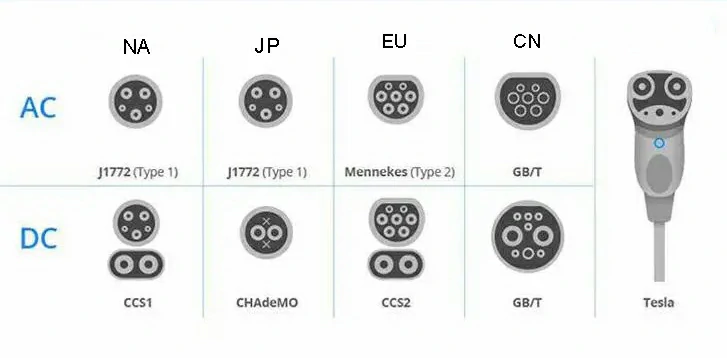
Vehicle-to-Grid (V2G): The Future of EV Charging and a Smarter Energy Grid
Vehicle-to-Grid technology is redefining the role of electric vehicles, turning them into dynamic energy assets that benefit drivers, utilities, and the planet.

Electromobility is to be steadily advanced. The charging option is also relevant here. While there was a wide choice of charging plugs for a long time, the Type 2 connection has established itself as the standard in Europe. In our overview, we list other charging plug variants and cables, revealing the differences and what e-car owners need to bear in mind when charging.
An electric car has many advantages. However, to guarantee reliable use on longer journeys, owners should know about different charging plugs and charging cables when it comes to setting. The following factors are relevant:
Plug types: Type 1, Type 2, CCS, CHAdeMO, and the Supercharger from Tesla are common plug types when e-mobilises are on the road in Germany. It is essential to determine which variant is compatible with one’s e-vehicle.
Standard connector: For European e-cars, the Type 2 connection has become established, which is compatible with a so-called Mennekes plug. This means that it has established itself as the standard in Germany. This also applies to home charging via a wallbox. Alternatively, there are often CCS connections at public fast-charging stations.
Charging cables: The choice of charging cables is more limited than the choice of charging plugs. There are only Mode 2 and Mode 3 charging cables on the market. Mode 2 is often designed for emergency charging at a socket, while Mode 3 is designed for connection to a (public) charging station.
Due to different electricity networks and standardization, different systems are used, especially for charging plugs. We have listed the most crucial plug types here.
The type 1 charging plug was already defined in 2009 and is primarily designed for the 120/240 V single-phase three-wire network used in North America and is also widely used in Asia. Because of the single current phase, the maximum charging power is limited to 7.4 kW, resulting in a voltage of 230 V and a maximum amperage of 32 A. Thus, it represents a disadvantage in Germany, which offers higher charging powers with its three-phase power grid.
Another disadvantage of the plug is that it does not have a standard locking mechanism on the vehicle. However, this locking device serves on the one hand for electrical safety, but on the other hand also for theft protection. It is, therefore, possible for unauthorised persons to remove the charging plug during the charging process. This problem is less relevant in the USA because the charging cables are permanently connected to the charging stations. Some models also have a lock on the vehicle side, so it is no longer possible to interrupt the charging process without further ado.
The Type 1 plug is mainly used by Asian manufacturers Type 1 plug is primarily used by Asian manufacturers. Although charging plugs are increasingly being standardised and the Type 2 plug is being used more and more due to its design advantages,
It is mainly vehicles from Asian manufacturers that are found on the German market that have a Type 1 connection on the vehicle side. For use in Europe, the manufacturers supply a charging cable with a type 1 connection on one side and a type 2 plug on the other. The plug is said to be suitable for 10,000 plug-in cycles, corresponding to a service life of 27 years.

Source: jointcharging.com
The charging plug or Type 2 charging cable is now well established in this country. Anyone who buys a new electric car in Europe is usually supplied with such a charging plug: Audi, BMW, Mercedes-Benz and its cooperation partner BYD, Smart, Renault, VW, Volvo and Tesla rely on this standard. The plug is suitable for both a 1-phase and a 3-phase power grid. This results in a maximum charging power of 43 kW in 3-phase operation when fast charging points are used in public areas.
This type is also often referred to as the “Mennekes” plug, which indicates the German company involved in its development. Besides its widespread use and universality, the plug’s advantages are that it is straightforward to use. Furthermore, the robustness is high; even running over it with a car should not usually cause any damage. In addition, the Type2 plug is designed for many 1,000 plug-in operations. Incidentally, the two smaller of the seven pins are not intended for the flow of electricity but communication with the vehicle.

Source: jointcharging.com
This plug variant is an extension of the proven Type 2 plug. Two additional contacts ensure the possibility of fast charging in both DC and AC networks. In theory, this plug type supports up to 170 kW charging power, in practice it is usually less than a third.
The CCS or Combo 2 plug is an extension of the Type 2 plug for DC chargingThe CCS or Combo 2 plug is an extension of the Type 2 plug for DC charging.
The advantage of the CCS plug is that the connections can also be used by a conventional and now very common type 2 plug. In this way, no further incompatibilities arise, nor are adapters necessary.
This Japanese plug system allows fast charging with a maximum charging power of 100 KW. This makes it inferior to the CCS plug, but in most cases only 50 kW can be provided at public charging stations anyway. Vehicles from Citroën, Honda, Kia, Mazda, Nissan, Mitsubishi, Subaru, Toyota and, with an adapter, Tesla are compatible with this type of plug. Nevertheless, experts assume that sooner or later the CHAdeMO plug will be displaced. A shift in favour of CCS is already discernible.
The CHAdeMo plug is the Japanese standard for fast charging for DC voltageThe CHAdeMo plug is the Japanese standard for fast charging for DC voltage
Tesla uses its own standard for the manufacturer’s own charging stations. This type of plug is a modified version of the Type 2 plug, which enables a charging power of up to 120 kW in the DC network. With the Model S, the battery can be charged up to 80 percent within 30 minutes.

Source: jointcharging.com
SchuKo plug for emergency charging
The SchuKo plug (an acronym for protective contact) should also be mentioned here for the sake of completeness. It is the conventional household plug for a maximum current of 16 A in the single-phase 230 V mains.
At least one emergency charge is possible with the ordinary household socket with its SchuKo plugAt least one emergency charge is possible with the ordinary household socket with its SchuKo plug.
The plug type allows a maximum charging power of 3.7 kW. However, this is only a short-term peak value that can be taken from the household socket. To avoid overheating and cable fires, only a maximum of 2.3 kW should be drawn permanently. This type of charging is therefore also called “emergency charging” and should be an exception. For private charging, e-car owners should rely on their own wallbox.
The blue CEE plug is often referred to as the “camping plug”. Long before the topic of electromobility gained any importance at all, motor homes were already being connected with it at campsites. Like the SchuKo plug, the CEE plug is also designed for the 230V mains.
The advantage over the conventional SchuKo plug, however, is that a current of 16 A is also possible as a continuous load and there is no unacceptable heating. This means that the charging capacity can be increased compared to the SchuKo plug. Today, however, this type of plug is uncommon for electric cars. Those who build a wallbox in their garage usually use one of the more powerful plug variants such as the Type 2 or CCS plug.
1-phase “blue” CEE plug, also known as camping plug1-phase “blue” CEE plug, also known as camping plug. The red CEE plug, on the other hand, has 3 phases and is also known as a power socket. Often you will find one in the basement or garage of your house.
Depending on the fuse protection and the design of the power connection, 11 kW or 22 kW charging power can be delivered here in most cases. If such a circuit is subsequently converted for the installation of a wallbox, it must be used exclusively for this purpose from then on, as parallel connection is not permitted.
3-phase “red” CEE plug, also known as heavy current plug3-phase “red” CEE plug, also known as heavy current plug.
The type 3A plug was developed in 2010 by the so-called “EV Plug Alliance”, in which companies such as SCAME and Schneider Electric were involved. Its special feature is a so-called shutter function (similar to that of cameras), which prevents the direct connection of current-carrying components. In addition, the costs should be lower than for the type 2 plug. For a long time, the type 3 plug was therefore favoured.
However, retrofitting the Type 2 plug with a shutter ultimately led to the latter being selected by the EU as the European standard – as a result of which the Type 3 plug no longer has any major significance today. The type 3A plug only allowed 1-phase charging, the type 3C plug also allowed 3-phase charging and up to 43 kW charging current.

We have summarised the most critical factors in a diagram to see the differences and similarities.
It is clear that established charging solutions such as the Type 2 plug and CCS plug are characterised by a high maximum charging power. This explains why, for example, the socket in this area should rightly only be used for emergency charging.
There are only two types of charging cables. These are presented below:
The so-called Mode 2 charging cable is available in different variants. One is often supplied for connection to ordinary household sockets, so that a slow emergency landing can be made at one’s own socket.
To enable communication between the charging connection and the vehicle, a so-called ICCB (in-cable-control box) is integrated into the charging cable. This charging box usually also makes it possible to set the current in amperes. This ensures that the fuse does not blow in the case of foreign sockets whose fuse protection is unknown.
The Mode 3 charging cable connects the charging station and the electric car. Here, communication takes place between the charging station and the vehicle, which is why the cable – unlike Mode 2 – does not have a corresponding control system. The charging cable as such is robust and also enables charging with very high charging currents. When buying a charging cable, the only thing you should pay attention to is the correct plug type.

The most common plug types for electric cars in Germany are:
Type 1 plug
Type 2 plug
CCS or Combo plug
CHAMdeMO plug
Tesla Supercharger
In principle, charging is possible at a standard household socket. However, this should be the absolute exception for e-car charging and only an emergency solution. A socket is not designed for such a continuous load. It can take up to 24 hours until the vehicle is fully charged.
By comparison, a wallbox with a type 2 plug can reduce the charging time to up to 2 hours, depending on the charging power. This is not only significantly faster, but also safer than using a wall socket, which can cause fires in the worst case.
Most electric cars come with a type 2 plug when you buy them. These include Audi, Hyundai, BMW, Peugeot, Porsche, Jaguar and Mercedes.
Vehicles compatible with CCS plugs include models from Toyota, Nissan, Mitsubishi, Honda and Kia, for example.

Vehicle-to-Grid technology is redefining the role of electric vehicles, turning them into dynamic energy assets that benefit drivers, utilities, and the planet.

At this ACT Expo, Joint Tech will unveil its latest advanced commercial Level 2 charging solution, designed to enhance the user experience. Meanwhile,powered by new technology, our commercial chargers effectively address multiple challenges encountered in real-world applications.

The new tariffs imposed by the United States have once again caused global economic tension.In order to respond to the impact on the global supply chain, Joint new factory in Malaysia offers favorable tax rates.